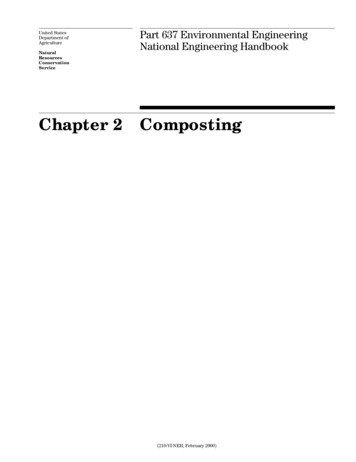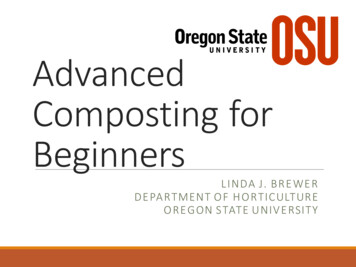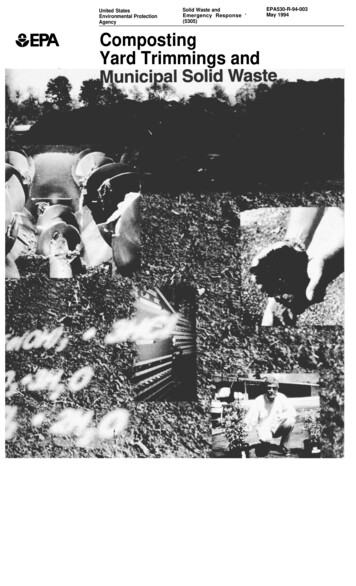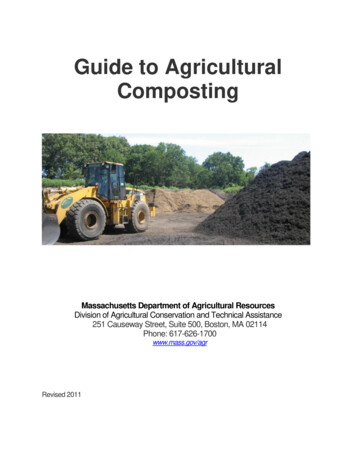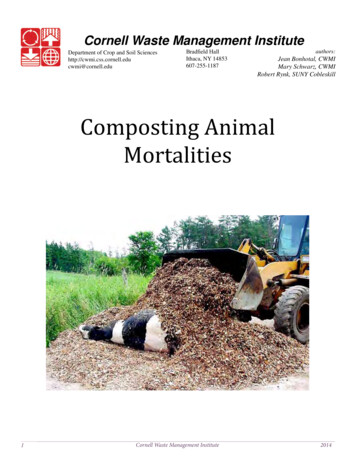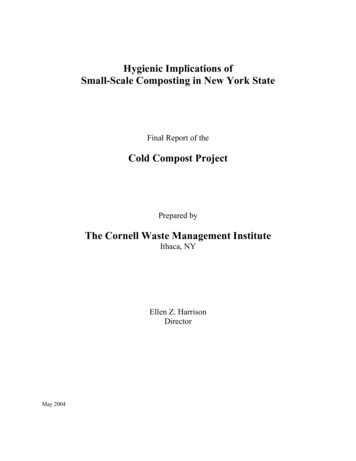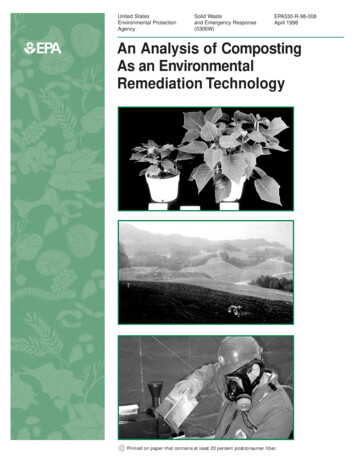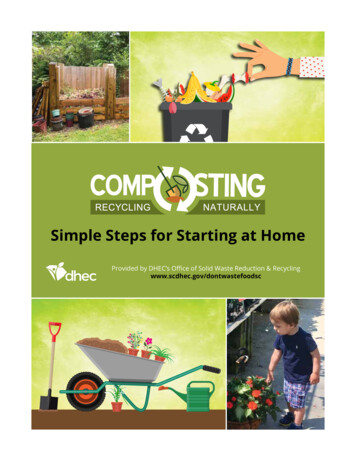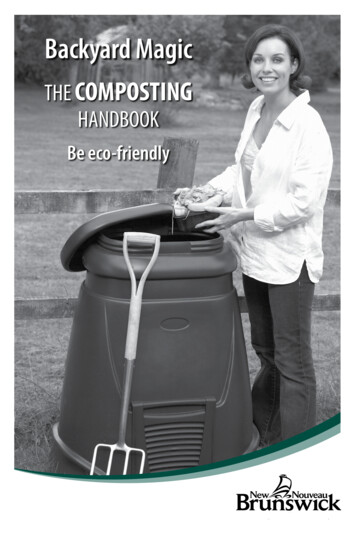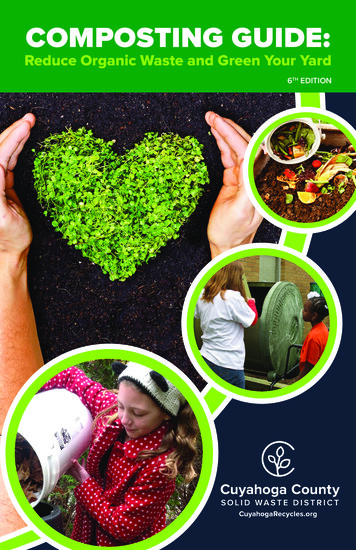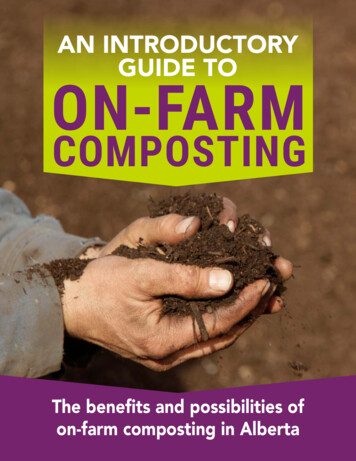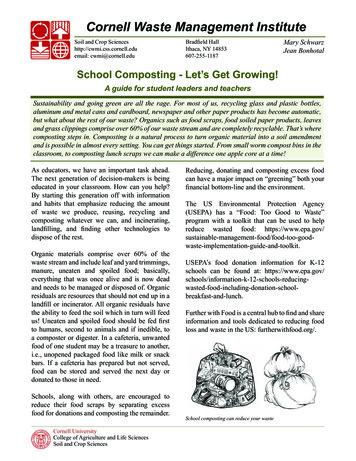
Transcription
Cornell Waste Management InstituteSoil and Crop Scienceshttp://cwmi.css.cornell.eduemail: cwmi@cornell.eduBradfield HallIthaca, NY 14853607-255-1187Mary SchwarzJean BonhotalSchool Composting - Let’s Get Growing!A guide for student leaders and teachersSustainability and going green are all the rage. For most of us, recycling glass and plastic bottles,aluminum and metal cans and cardboard, newspaper and other paper products has become automatic,but what about the rest of our waste? Organics such as food scraps, food soiled paper products, leavesand grass clippings comprise over 60% of our waste stream and are completely recyclable. That’s wherecomposting steps in. Composting is a natural process to turn organic material into a soil amendmentand is possible in almost every setting. You can get things started. From small worm compost bins in theclassroom, to composting lunch scraps we can make a difference one apple core at a time!As educators, we have an important task ahead.The next generation of decision-makers is beingeducated in your classroom. How can you help?By starting this generation off with informationand habits that emphasize reducing the amountof waste we produce, reusing, recycling andcomposting whatever we can, and incinerating,landfilling, and finding other technologies todispose of the rest.Organic materials comprise over 60% of thewaste stream and include leaf and yard trimmings,manure, uneaten and spoiled food; basically,everything that was once alive and is now deadand needs to be managed or disposed of. Organicresiduals are resources that should not end up in alandfill or incinerator. All organic residuals havethe ability to feed the soil which in turn will feedus! Uneaten and spoiled food should be fed firstto humans, second to animals and if inedible, toa composter or digester. In a cafeteria, unwantedfood of one student may be a treasure to another,i.e., unopened packaged food like milk or snackbars. If a cafeteria has prepared but not served,food can be stored and served the next day ordonated to those in need.Schools, along with others, are encouraged toreduce their food scraps by separating excessfood for donations and composting the remainder.Cornell UniversityCollege of Agriculture and Life SciencesSoil and Crop SciencesReducing, donating and composting excess foodcan have a major impact on “greening” both yourfinancial bottom-line and the environment.The US Environmental Protection Agency(USEPA) has a “Food: Too Good to Waste”program with a toolkit that can be used to helpreduce wasted food: USEPA’s food donation information for K-12schools can be found at: eakfast-and-lunch.Further with Food is a central hub to find and shareinformation and tools dedicated to reducing foodloss and waste in the US: furtherwithfood.org/.School composting can reduce your waste
School Composting - Let’s Get Growing!This document provides you with:1. Ideas for incorporating composting into thecurriculum.2. Steps to take to start a school composting/diversion program.3. Descriptions of successful school compostingprograms.Ideas for Incorporating Compostinginto the CurriculumThere are far-reaching benefits of a compostingprogram for the school community. Whenstudents begin to manage their own food scrapsthey are inevitably drawn into broader learningrelated to ethics, personal responsibility andenvironmental citizenship. Taking responsibilityfor the solid waste stream at school empowersstudents by giving them a specific action to helptheir community and the earth. Members of theteam that are trained will continue to be leadersthroughout their tenure in school and trainadditional leaders. Younger students who receivethe education will make the action a life-longhabit. If trained effectively their ethic will carryon throughout their lives. Environmental issuessuch as protecting water, soil and air will providejobs now and in the future, and youth that possessa good understanding of these issues will be betterprepared for the future.There are a number of ways in which compostingcan be integrated into the curriculum whilemeeting many learning outcomes. Integraterecycling/composting into your science program,have a poster contest in your art program, collectre-usable items as a community service project.Specifically: Younger students can analyze the compositionand texture of finished compost, or can compareplants grown in soil with and without compost. Science classes, such as chemistry, can checkthe temperature, pH, mass, density and carbonand nitrogen content of compost at various stagesof decomposition. These measurements are vitaldiagnostic tools in managing a compost pile.2The Green Team at Seneca Falls Middle School, along withadult volunteers, build a compost bin Biology students can study the complex webof organisms and interactions that help to createcompost. Social studies classes can examine howcomposting reduces the need for landfills andlowers associated waste management costs. Math classes can calculate compost recipes,record the data, and create visuals for the rest ofthe school to evaluate how they are doing as wellas bringing that message home to their familiesand community. Physical education classes can turn the compostand distribute finished product to planted areason the school grounds. Finally, the loop can be closed by growingfood, in the compost amended soil, to serve in thecafeteria or special events and start the processall over again.Trash Goes to School (available at: http://hdl.handle.net/1813/14280) is an excellent resourceto teach all ages about managing our solid waste.Additional curriculum materials can rriculum.htm. Materials in Spanishcan be found at http://cwmi.css.cornell.edu/spanish.htm.Cornell Waste Management Institute2017
School Composting - Let’s Get Growing!Steps to Take to Start a SchoolComposting/Diversion Program Form a Team Promote the Idea Assess the Situation Decide on a Strategy Develop a Collection System Start the Program Use your ProductForm a TeamBefore moving forward with implementingcomposting as a waste management tool, studentsand teachers will need to present the idea to thePrincipal and/or Superintendent and the Board ofEducation. Starting to compost school organicswill take a commitment to change the statusquo and implement for long-term change. It isimportant for the process to continue even if/when students and teachers move on. It takescommitment from cafeteria staff, maintenancepeople and teachers in different grade levels thatwork it into their long-term curriculum and ofcourse school leadership. Science teachers canusually have vermicompost bins without schoolbuy-in but setting up composting for a wholeschool district needs approval. Composting is agreat tool to teach naturalresourcemanagement,biology and chemistry.Applied learning is themost ning a compostingprogram is to have a team of“compost kids” who help toadvocate for composting,design the system to usein the school and whoactively and consistentlymaintain and monitor theprogram. This team should3include representatives from administration,teachers, maintenance, food service, students andparents and choose an adult coordinator. Thecoordinator will be responsible for all aspects ofthe program, but will need to delegate tasks toother members of the team. Make sure there isbuy-in/support from all representatives. Decide which students will participate. Will itbe a student club or organization, or will it be aclass? An environmental or other club might takeon composting as a service learning project, whichis then adopted as a school-wide program. A teamof teachers could build a composting programinto the science or social studies curriculum, orstudents learning about composting in scienceclass, may want to develop a program. Set goals as a team, such as:* Should separation and collection be from thekitchen only, or cafeteria-wide?* Will diversion of organic waste be to a nearbycomposting facility or farm, or will it be doneon-site? The team is responsible for promoting thebenefits of recycling and composting to the restof the school. Use posters, announcements andassemblies to get the information out. Explainwhy recycling and composting are importantand how easy it can be when organized. SomeClose to 70% of this school’s lunch waste was compostable, while only 5% is actually trashCornell Waste Management Institute2017
School Composting - Let’s Get Growing!frequently asked questions aboutcomposting can be found on page 14.schoolPromote the IdeaThe school community will need to know whatis happening and why. Promotional material andsignage are important to any new recycling andcomposting program. Suggestions for on-goingeducation before, during and after the programhas been implemented include: Have a school-wide assembly to kick off theprogram. Newsletters to parents to garner parentalsupport. Posters around the school and in the cafeteriathat promote the benefits of reduction, recyclingand composting. Bin signs showing students what to put where.Drawings and/or actual materials on the signsgive visual confirmation of what goes in eachbin. Color-coding also helps. Consider green forcompost, blue for recycling, a bucket for liquids,and gray for trash. And, consider using a verysmall bin for the “trash”. Morning announcements reminding studentsthat everyone’s help is needed for the program tobe a success. School blogs are a great way to discuss theprogram and spread the word. Praise and encouragement in the form oft-shirts, stickers and other special rewards suchas field trips and “pep rallies” are also helpful tokeep the momentum going.Assess the Situation: Conduct a Weighand SortWeigh and sorts quantify the type of wastesgenerated from cafeteria activities. Conductinga weigh and sort allows schools to gain insightinto what students are and are not eating and cantherefore make better decisions about what tooffer to reduce waste. It allows students and staffto see first-hand how much they would be able toreduce their trash disposal if they composted andrecycled, and gives them an idea of what type and4Students learn where to put whatsize composting system and how much carbonmaterial they will need. Conducting the weigh andsort for several days or over a week will generate amore accurate understanding of waste generated. Materials:* Plastic disposable gloves for handling food.* Data sheets: School Food Scrap Data andFoods Thrown Away (Appendix A). Thesesheets can be revised to fit the actual lunchperiods at the school.* Four or more “known volume” containers: onefor food scraps and food soiled paper productssuch as napkins, paper towels and paper strawwrappers, one for recyclable bottles, cans, etc.,one for disposable service ware, and one for allother material.* One or more fivegallon pails forleftover milk.* Clipboardsforholding/recordingon data sheets.* Scale (if one isavailable) to weighempty and fullcontainers. Procedure:* Label each of the4 containers withtheappropriateFood scrap sign for diversion tolabel (food and a commercial facilityCornell Waste Management Institute2017
School Composting - Let’s Get Growing!compostable paper; recyclables; disposableforks, knives, spoons; trash) and use pictures todepict items if possible. Label the milk pail(s).* Weigh the empty containers and record onthe data sheet. If no scale is available, recordthe total volume of the container.* Record on the “Foods Thrown Away” datasheet what is on the menu for the day.* When students bring their trays back, instructthem to pour their leftover milk into the milkpail and help them separate the contents ontheir tray into the appropriate containers.* Record on the “Foods Thrown Away” sheethow much of each item is discarded by puttinga hash mark in the appropriate column. Useextra spaces to record the contents of baglunches if desired. If interested, to learn why people don’t eatcertain food, interview students and write downtheir comments.* At the end of each lunch period (or when it isconvenient), weigh the containers and record inthe appropriate places. If no scale is available,estimate how full the container is after eachperiod.* Record the total amount of milk discarded.* Use this data to create graphs and othervisuals showing how much can be recycledand how much should actually be thrown away.Many schools are surprised by the very smallamount of actual “trash” they generate. Other things to think about in the weigh and sortthat can have an impact on waste management:* Styrofoam trays vspaper/compostabletrays vs reusabletrays vs trayless.* Plastic utensils vsreusable.* Are milk cartonsand juice boxesrecyclable?* Do you have a“donation”table/cooler/refrigeratorSignage with actual items5for unopened or unwanted food, such as milkand fruit?* Do you have a plan for donating prepared,but not served food?Decide on a Strategy (offsite or onsite)Recycling of food scraps can occur in one of threeways in schools. On-site composting in bins onschool grounds, classroom composting usingworms, or diversion of food scraps to a farm orcentralized composting facility. Composting in Bins: Schoolyard compostingis just like residential composting in whichbuckets of food scraps are regularly tipped intoan outdoor holding bin on the property. Thebin should be placed in an out of the way butconvenient location away from water suppliesand school air intakes. There are many systemsavailable for onsite composting. Commerciallyavailable bins or tumblers are a good choicefor small volumes, such as kitchen prep wasteonly. Turning units built out of untreated woodare an economical choice for cafeteria-widesystems with larger volumes. The choice of whatsystem to use depends on space, time and moneyavailable. See figure 1 for plans for a wooden2-bin system (please note that the width of eachbin in these plans is 6’, but this can be adjustedto fit the width of the bucket loader or bobcatavailable at the school). There will be daily tasksthat need to be carried out in order to compost onschool grounds (see Start the Program, page 7). Worm Composting: Did you know thatworms can eat leftovers! Before you say “yuck”,note that this composting system is not onlyinteresting, it works! The worms work in acontainer and help process food scraps givingoff only an earthy smell. The potential of wormcomposting to manage waste is a great way toteach ecology, biology, sustainability and caringfor the workforce (the worms and other microbesthat do the work). See Vermicomposting, page 8. Organics Diversion: If your school has accessto a commercial compost facility or farm thatcan take food scraps for composting, offsitecomposting may be a good choice. The specificsCornell Waste Management Institute2017
School Composting - Let’s Get Growing!of what can be composted, where the scraps willbe stored until pick-up/delivery and how oftenthis will occur will have to be negotiated with thefacility receiving the material. Some examplesof schools doing this can be found in SuccessfulSchool Programs, page 9.Develop a Collection SystemIt is helpful to color code your collection system.Make sure the containers and lids are well labeled.Laminated signs or posters behind the cans are agreat way to communicate what goes where. Collection buckets or bins will be used. Fivegallon buckets with lids work well. These areoften available at no cost from restaurants orstores. Food scraps are heavy, so keep the pailsize small, especially if students will be movingthe material. Collect recyclables in cans with a hole cut inthe lid (round holes for cans and bottles, squarefor milk cartons) to remind students it is forrecycling only. Use a very small can for “trash” as this shouldhave the least amount of material in it. Include a strainer on the liquid collectionbucket to keep straws and other solids out. Flat carts with wheels, or wagons are helpfulfor carting the buckets around. Make sure thecarts are sized to maneuver around the kitchen,cafeteria and doorways. Develop a schedule of tasks (cafeteriamonitors, bringing food scraps to the composter,collecting brown material, etc.) and assignstudents, teachers and volunteers, rotating thesetasks, so that experiences can be shared and noone “burns out”.Fig. 1: 2-bin composter top view - available at http://hdl.handle.net/1813/45758Materials ListUseEnd wallEnd wallSide wallsSide on4x42x62x62x62x62x42x6Full Length12’14’12’12’12’12’14’Cornell Waste Management InstituteCut into (qty)71212726324Cut Length72”13’ 6”72”72”72”72”74”2017
School Composting - Let’s Get Growing! Collectdailytallies of ding weightsor volumes ofliquids, food scrapsand recyclables.Start the ProgramOn-site CompostingThree-bin system with 4th bin for holding brownsThe following tasks will need to be carriedout in order to compost in bins on-site. Theseshould be scheduled by the Team. Scheduling willdepend on school lunch schedules, availability ofvolunteers and what works best for kitchen andcustodial staff involved. Collect food scraps. Weigh food scraps: Recording the weightcan be used to keep track of the total amount oforganics processed in a given amount of timeshowing the savings in solid waste disposal. Itcan be compared to the weight of the finishedcompost product to establish loss of materialthrough composting. Weight records can be usedfor calculating math problems. Classes can trackand analyze the compost operation, including theamount of food processed. Transport food scraps to bins: This can be doneby students, staff or other volunteers, dependingon the weight and amount of material beingtransported. Take temperature: Taking the temperatureof the pile is a way to monitor the compostingprocess. A working compost pile will go throughstages, getting hotter as the microorganismsstart digesting the material and cooling off asthe material decomposes. A working compostpile should measure between 104 and 150oF.When the temperature drops below this it is anindication that the balance of food, moisture andair needs to be adjusted, most likely by turninginto the next bin, or that it has finished its hotphase and needs to be moved to cure.7 Spread the food scraps: Food scraps shouldbe layered on top of a layer of brown (carbon)material, leaving a 1-2’ edge of brown materialaround it so that no food is visible when morebrown material is put on top. Layer with bulking material: Several inchesof carbon (brown material) should be spreadon top of the food scraps to cover the foodcompletely. The brown material acts as a filterto soak up the moisture from the food scraps andeliminate odor. You will need a large source ofcarbon based materials such as dry leaves, woodshavings/sawdust or woodchips. Carbon shouldbe available at a ratio of 2 or 3:1. That is, forevery unit of food scraps, 2-3 units of carbonwill be needed. Source wood chips from localcompanies such as the highway department,utility company or a tree company. Gather leavesin the fall and stockpile them. Save sawdust andshavings from Technology Classes.Students spreading food scraps in a binCornell Waste Management Institute2017
School Composting - Let’s Get Growing! Add the superstar food processors, red wigglers(Eisenia fetida). The worms process 2-3 timestheir weight in food each day. Students can take turns feeding the worms, butneed to be careful not to overfeed! Feed, waterand fluff. To keep worms happy, feed them aboutonce a week. If the bedding dries up, spray withwater, if it gets too wet, add more dry material.Fluff up the bedding once a week so the wormsget enough air. As time goes on, the worms work tirelessly toeat your leftovers and produce compost. More information on worm composting can befound at http://compost.css.cornell.edu/worms/basics.html and actured drum composter Clean up: Wash and wipe off shovels andthermometers, and rinse out the food scrapbarrels or bucket. When the first bin is full, it can be turned intothe second bin and left to work/cure, while fillingthe first bin again. Troubleshooting problems inyour composting system can be found on page13.Vermicomposting in the ClassroomWorms eat organic matter, bacteria and fungi andrelease castings, which is the finished compost.Worm composting is especially good for schoolsthat have no yard space. The worms stay in the box,eat the food scraps and do not smell. Compostingin a worm bin can be done through the followingsteps: Acquire a bin. Reuse an old dresser drawer,build a box out of wood or find/buy a plastic bin. Prepare the bedding. Wet paper, leaves,sawdust and other carbon sources are placed in acontainer that has some air holes in it. Since theworm workers need moisture, check to make surethat the mixture feels like a wrung out sponge. Mix in some food scraps. Cut or break the foodscraps into small pieces – the smaller, the better.8Use the ProductYour first batch of compost should be ready in4-6 months with turning, or 6-12 months withoutturning. The finished product is a dark crumblysoil-like mix with small pieces of organicmaterial. It should have an earthy smell. Compostcan be used in landscaping, growing food for thecafeteria or as a topdressing on athletic fields. Theaddition of compost on or in the soil has a numberof benefits: Compost improves soil structure, porosity anddensity, creating a better plant food environment. Compost increases water infiltration andpermeability in heavy soils and improves waterholding capacity in sandy soils, making nutrientsmore plant available. Topdressing compost on athletic fields improvesplayability. The addition of organic matterpromotes aggregation of soil particles, increasingporosity and reducing bulk density to make a lesscompact soil.Cornell Waste Management Institute2017
School Composting - Let’s Get Growing!mixed with soil for perennial plantings around theschool. The students really like doing this becauseit makes them feel like they are doing somethinggood and are making a difference for the planet.Lessons learned: Drum composters need toprocess a whole batch at a time. One to ten poundsin a big drum will not start to process until full.Long time composting programExamining worm bin contents at a preschoolSuccessful School ProgramsOn-site CompostingComposting lunch scraps on school groundsFifth and 6th grade science classes at CandorElementary School, Candor, NY, startedlearning about decomposition. They learned thatdecomposition involves all kinds of neat creepy,crawly critters you can see with your eyes, andmicroorganisms like bacteria and protozoa youwill need a microscope to see. The compostingenvironment creates conditions to speed up theprocess of decomposition. Food scraps (wet, green,nitrogen-rich material) and dry, brown carbonrich material are mixed together to create a habitatfor the decomposers. These critters are the “workforce” and are able to break down organic matterand turn it into a soil conditioner on which plantsthrive. The students at Candor wanted to see thesemicro and macro organisms first hand, and do theirpart for sustainability. They learned what to do ina school program, purchased compost containers,and are happily composting food scraps fromthe cafeteria, shredded paper, lawn clippings andsawdust from the woodworking classes. Staff andthe 6th graders help the younger kids separatetheir “compostables” from their trash. Studentsdeliver the scraps to the compost unit, add thecarbon source, sawdust and leaves, and mix itby giving it a full turn. Their process takes about6-9 months to produce compost that will then be9About 15 years ago, Bunny Goodwin, a MasterGardener volunteer, worked with students to starta composting program at Keene Central School.They built concrete bins and layered their foodand carbon source in the bins on a regular basis.It is turned a few times per process with the townBobcat. Food collection begins in the schoolcafeteria and ends in the bountiful harvest offlowers and vegetables that sometimes becomelunch. These composting programs preventvaluable organic waste from ending up in thelandfill, provide a unique educational opportunityfor students (and teachers as well) and nourishand amend the soil in school gardens. In turn,many kids and teachers have started compostingat home, multiplying the green effect.Start small, expand district-wideIn 2012, the middle school in the BethlehemCentral School District started a separation andcollection program in the cafeteria. Their DistrictGreen Team is responsible for the program. Thereare recycling stations in all cafeterias with separateslots for compostables, recyclables, liquids andgarbage. Their biggest hurdle was the cost; payingfor a compost pick-up and composting receptacles.These were paid for by savings through energyperformance contracts that provided additionalfunding. They compost their waste at the middleschool in Earth Tubs using leaves from the schoolgrounds as their source of browns. They use thefinished compost in the school garden. In 2015, theprogram went district-wide. This additional foodscrap is hauled away by a composting company.As there is buy-in from administration and headcustodial staff, BCSD is confident their programwill be sustainable.Cornell Waste Management Institute2017
School Composting - Let’s Get Growing!started. It helped that our composting conversationbegan at the District Steering Committee andincluded our superintendent, all administrators,teachers, staff, and parents. Our goal was toreduce what we throw away, because in doingthat we are more environmentally friendly andalso save money in trash hauling expenses. Wewere fortunate to have the support of the DistrictSteering Committee, the Director of Facility andMaintenance, and the Cafeteria Manager. Once thebins were built we also had to determine the bestmechanism for collecting food waste, deliveringit to the bins, and setting up a regular schedule forcomposting.Cafeteria recycling stations, Bethlehem Central School DistrictSeneca Gr&een Club composts on-siteby Barb Reese, Seneca Gr&een Club AdvisorOur school composting program began inMarch 2014 when interested students, staff andcommuity partners gathered to build our composbins on Seneca Falls Middle School campus. Wehad previously completed food waste studies atour school cafeterias so we had an idea of howmuch food was being thrown away. Our highschool student council also financed a monthlong trial using a compost service where our foodwaste was picked up weekly and composted offsite. We found the service to be cost prohibitiveand decided to build our own bins and composton-site.The composting program is currently overseen bytwo teachers and their students, along with schoolfacility and maintenance staff. Barb Reese is theadvisor of the Seneca Gr&een Club and with herclub is responsible for maintaining an active pile,securing adequate cover materials, schedulingperiodic turning of static piles, and ensuring thatno problems with odors or vectors arise. DistrictEnglish teach Diana Foster and memebers ofher English class are responsible for weeklycomposting of the food waste that is collected. Ourschool custodial staff is responsible for collectingthe food waste. Mainenance staff help rotate thepiles when needed.The most difficult hurdle was getting the program10Our greatest success is hard to single out becausethere are many. Over the past three years we havediverted approximately 50,000 pounds of foodscraps from our local landfill. Composting onsite has exposed our students to the process andhas helped some fulfill their community servicerequirement for graduation. We’ve shared ourschool compost with community gardeners andare also using it in a new garden at one of ourelementary schools.Each day food waste is collected in all four ofour school district cafeterias. All liquid waste isdumped into a bucket and poured down the drain.We accept ALL food items including neats, dairy,fats, and oil. Food waste from our elementary andmiddle schools gets picked up daily by farmersto feed their chickens and pigs. Food waste andpaper items from our high school cafeteria getsdelivered by our custodian to a secure container atthe compost bins.Green Club members harvesting finished compostCornell Waste Management Institute2017
School Composting - Let’s Get Growing!Once or twice a week members from SenecaGr&een or from Mrs. Foster’s English classempty the food waste into the active compostbin and cover it with wood chips and other covermaterials available. When the active pile bin isfull, our maintenance department uses a bucketskidsteer to turn the pile into and empty bin whereit heats up and decomposes further. A new activepile is started with browns on the bottom.We currently have a four bin composting systemthat allows for an active pile, a bin for covermaterials, a curing pile, and a bin to rotate into.We’ve partnered with two tree service companiesthat are willing to deliver wood chips to us asneeded.Curing pile (left), active pile (right)So far we’ve managed to grow the program fromone school to include all four. It helps that wediversify where the food waste goes. Feedingfarm animals is a better use for food waste thancomposting, but if the farmers decide they don’twant it, we can compost it. Likewise, if weexperience problems with odors or lack of covermaterials we can give all food waste to the farmersinstead of composting. Diversifying where it goesgives us flexibility if
composting steps in. Composting is a natural process to turn organic material into a soil amendment and is possible in almost every setting. You can get things started. From small worm compost bins in the classroom, to composting lunch scraps we can make a difference one apple core at a time! As educators, we have an important task ahead.
